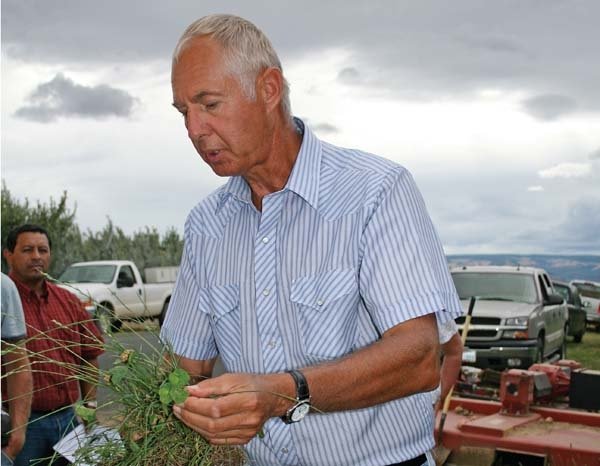
As commercial nitrogen fertilizers become more expensive, and potentially more limited in supply, the idea of growing fertilizer in the orchard is being explored.
Quincy, Washington, fruit grower Warren Morgan, who is pursuing more sustainable practices, has been growing cover crops between the rows, and then mowing and blowing the cuttings into the tree row as a mulch.
After initial results proved positive, Morgan began to look for a non-grass cover crop that would last for several years. He bought a four-foot-wide, no-till seed drill so that a legume cover crop could be planted in the alleys without disturbing the ground. Leaving the ground untilled helps conserve organic matter, avoids problems with dust and mites, and does not stimulate germination of weed seeds in the soil.
David Granatstein with Washington State University’s Center for Sustaining Agriculture, who is conducting a trial at Morgan’s orchard, said that most commercial nitrogen fertilizers are made from natural gas and increasingly produced overseas. Growing a portion, if not all, of an orchard’s nitrogen fertilizer within the orchard could represent a more stable and renewable supply with a smaller carbon footprint.
For organic growers, it can provide a source of nitrogen without the excess phosphorus and potassium often found in manure or compost. Using manure is also becoming expensive as the cost of hauling it increases, he noted.
Granatstein is using several perennial legumes in the trial:
—Alfalfa (Medicago sativa), a tall, high-yielding hay
—Ladino clover (Trifolium repens), a jumbo white clover
—Kura clover (Trifolium ambiguum), a long-lived, medium-sized clover
—Birdsfoot trefoil (Lotus corniculatus)
The legumes were seeded in May 2008. The no-till method resulted in good establishment of the plants, Granatstein said, although most did not grow well in the tractor tracks, reducing the effective width of the planting to three feet, rather than four.
He estimates the cost of planting a legume cover crop at $32 per acre for seed, plus another $52 for other planting costs, including labor. “We’re trying to find out if it can pay for itself,” he said.
The cover crops were mowed in August 2008. Granatstein estimates that the trefoil, ladino clover, and alfalfa clippings at mowing contained 11, 12, and 13 pounds of nitrogen per acre respectively, compared with 9 pounds in a grass cover crop. The kura clover, which is a slow-growing plant, produced only 6 pounds. The cover crops were mowed four times this year.
Kyle Blair with Soiltest Farm Consultants, Inc., of Moses Lake, Washington, said a plant root simulator probe can be used to monitor the nitrogen released after the cover crop has been mowed and placed in the tree row. However, nitrogen is mobile, and irrigation can make a big difference to the amount of nitrogen in the soil.
Dr. Steve Fransen, Extension agronomist at Washington State University, said the alfalfa in the trial is an exceptionally tall variety. It is good for hay but does not thrive in shade or where there is foot or tractor traffic. Other hay varieties, which are commonly used for pasture and have a deeper crown, might be more tolerant of being driven over, he said.
Granatstein said the white clover that typically grows in orchards is short. Two taller clovers were selected for the trial in order to produce more biomass. The kura clover is a long-lived species used in pastures. It takes about a year to become established and spreads in the ground via rhizomes. In comparison, some other varieties of clover, such as red clover, tend to become established more quickly but decline sooner. The kura clover doesn’t tolerate traffic well. The ladino jumbo clover does better under tractor tires and is also more competitive with weeds.
Fransen said clover has an advantage over other crops in a shady situation, such as between tree rows, because of its horizontal leaves that effectively intercept sunlight. Grass, which has vertically oriented leaves, is less effective at catching the sun.
Dandelions are a threat to a cover crop because of the way they compete with other plants, Fransen explained. Dandelions produce ethylene, which causes neighboring plants to quickly senesce and die. The competitive nature of dandelions can affect how long a cover crop, such as clover, will last. “That may be a real limiting factor,” he said. “Maybe instead of ten years, you’re going to get four to five years of productive life out of it.”
Granastein said the growth regulator Apogee (prohexadione calcium) is applied in the orchard to reduce shoot growth and could be affecting the growth of the cover crops too. “We’re trying to manage two crops, and they’re not always compatible,” he noted.
Fixing nitrogen
Fransen said the goal of growing a legume cover crop is not just to produce biomass, but also to fix atmospheric nitrogen and make it available to the trees when they need it. Nitrogen is fixed by soil bacteria called rhizobia after they become established in root nodules. The color of the root nodules indicates whether nitrogen fixation is occurring or not. If a nodule is pink inside, it is fixing nitrogen. If it is white, it is not. If it is green, the nodule is dead.
As well as supplying nitrogen to the trees, it’s important to keep up the phosphorus, potassium, and boron levels, especially in the fall, Fransen said. As the trees prepare to go into dormancy and winter survival mode, they need phosphorus and potassium to develop deeper roots and more storage sugars.
In previous trials, Granatstein has tested living mulches in the tree rows. One disadvantage is that there is no way to turn off the nitrogen supply to the trees. The living mulch delayed dormancy of the trees. There are advantages to growing the mulch separately in the alley, he said, and fewer problems with rodents, too.

Leave A Comment